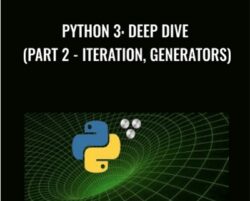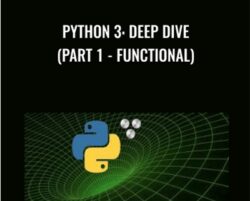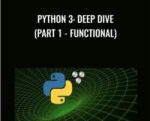What you’ll learnAn in-depth look at variables, memory, namespaces and scopesA deep dive into Python’s memory management and optimizationsIn-depth understanding and advanced usage of Python’s numerical data types (Booleans, Integers, Floats, Decimals, Fractions, Complex Numbers)Advanced Boolean expressions and operatorsAdvanced usage of callables including functions, lambdas and closuresFunctional programming techniques such as map, reduce, filter, and partialsCreate advanced decorators, including parametrized decorators, class decorators, and decorator classesAdvanced decorator applications such as memoization and single dispatch generic functionsUse and understand Python’s complex Module and Package systemIdiomatic Python and best practicesUnderstand Python’s compile-time and run-time and how this affects your codeAvoid common pitfallsCourse contentExpand all 158 lectures44:38:14+Introduction+A Quick Refresher – Basics Review+Variables and Memory+Numeric Types+Function Parameters+First-Class Functions+Scopes, Closures and Decorators+Tuples as Data Structures and Named Tuples+Modules, Packages and Namespaces+ExtrasRequirementsBasic introductory knowledge of Python programming (variables, conditional statements, loops, functions, lists, tuples, dictionaries, classes).You will need Python 3.6 or above, and a development environment of your choice (command line, PyCharm, Jupyter, etc.)Hello!This is Part 1 of a series of courses intended to dive into the inner mechanics and more complicated aspects of Python 3.This is not a beginner course – if you’ve been coding Python for a week or a couple of months, you probably should keep writing Python for a bit more before tackling this series.On the other hand, if you’re now starting to ask yourself questions like:I wonder how this works?is there another way of doing this?what’s a closure? is that the same as a lambda?I know how to use a decorator someone else wrote, but how does it work? Can I write my own?why isn’t this boolean expression returning a boolean value?what does an import actually do, and why am I getting side effects?and similar types of question…then this course is for you.Please make sure you review the pre-requisites for this course (below) – although I give a brief refresh of basic concepts at the beginning of the course, those are concepts you should already be very comfortable with as you being this course.In this course series, I will give you a much more fundamental and deeper understanding of the Python language and the standard library.Python is called a “batteries-included” language for good reason – there is a ton of functionality in base Python that remains to be explored and studied.So this course is not about explaining my favorite 3rd party libraries – it’s about Python, as a language, and the standard library.In particular this course is based on the canonical CPython. You will also need Jupyter Notebooks to view the downloadable fully-annotated Python notebooks.Get Python 3: Deep Dive (Part 1 – Functional) – Fred Baptiste, Only Price $42It’s about helping you explore Python and answer questions you are asking yourself as you develop more and more with the language.In Python 3: Deep Dive (Part 1) we will take a much closer look at:Variables – in particular that they are just symbols pointing to objects in memoryNamespaces and scopePython’s numeric typesPython boolean type – there’s more to a simple or statement than you might think!Run-time vs compile-time and how that affects function defaults, decorators, importing modules, etcFunctions in general (including lambdas)Functional programming techniques (such as map, reduce, filter, zip, etc)ClosuresDecoratorsImports, modules and packagesTuples as data structuresNamed tuplesTo get the most out of this course, you should be prepared to pause the coding videos, and attempt to write code before I do! Sit back during the concept videos, but lean in for the code videos! Course PrerequisitesThis is an intermediate to advanced Python course.To have the full benefit of this course you should be comfortable with the basic Python language including:variables and simple types such as str , bool , int and float typesfor and while loopsif…else… statementsusing simple lists , tuples , dictionaries and setsdefining functions (using the def statement)writing simple classes using the class keyword and the __init__ method, writing instance methods, creating basic properties using @property decoratorsimporting modules from the standard library (e.g. import math)You should also:have Python 3.6 (or higher) installed on your systembe able to write and run Python programs using either:the command line, ora favorite IDE (such as PyCharm),have Jupyter Notebooks installed (which I use throughout this course so as to provide you fully annotated Python code samples)Who this course is for:Anyone with a basic understanding of Python that wants to take it to the next level and get a really deep understanding of the Python language and its data structures.Anyone preparing for an in-depth Python technical interview.Get Python 3: Deep Dive (Part 1 – Functional) – Fred Baptiste, Only Price $42Tag: Python 3: Deep Dive (Part 1 – Functional) – Fred Baptiste Review. Python 3: Deep Dive (Part 1 – Functional) – Fred Baptiste download. Python 3: Deep Dive (Part 1 – Functional) – Fred Baptiste discount.
 Meet the jack – Jorge Garcia
₹2,490.00
Meet the jack – Jorge Garcia
₹2,490.00
 Python 3: Deep Dive (Part 2 – Iteration, Generators) – Fred Baptiste
₹6,308.00
Python 3: Deep Dive (Part 2 – Iteration, Generators) – Fred Baptiste
₹6,308.00
Python 3: Deep Dive (Part 1 – Functional) – Fred Baptiste
₹6,308.00



